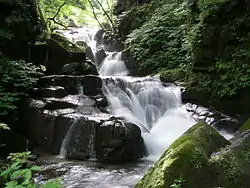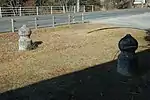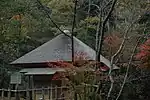List of Special Places of Scenic Beauty, Special Historic Sites and Special Natural Monuments
To protect Japan's cultural heritage, the country's government selects through the Agency for Cultural Affairs important items and designates them as Cultural Properties under the Law for the Protection of Cultural Properties. Designated items are classified in a number of categories, one of which is Monuments (記念物, kinenbutsu). This category includes historic locations such as shell mounds, ancient tombs, sites of palaces, sites of forts or castles, monumental dwelling houses and other sites of high historical or scientific value; gardens, bridges, gorges, mountains, and other places of great scenic beauty; and natural features such as animals, plants, and geological or mineral formations of high scientific value.[1][2]
The government further designates "significant" monuments classifying them in three categories: Historic Sites (史跡, shiseki), Places of Scenic Beauty (名勝, meishō), and Natural Monuments (天然記念物, tennen kinenbutsu). Items of particularly high significance receive higher classifications: Special Historic Sites (特別史跡, tokubetsu shiseki), Special Places of Scenic Beauty (特別名勝, tokubetsu meishō), and Special Natural Monuments (特別天然記念物, tokubetsu tennen kinenbutsu) respectively. As of October 24, 2023 there are 1,040 Natural Monuments, 1895 Historic Sites, 429 Places of Scenic Beauty, 75 Special Natural Monuments, 36 Special Places of Scenic Beauty and 63 Special Historic Sites.[3]
Since a single item can fall under more than one of these categories, the total number of sites is less than the sum of designations.
Criteria
The Agency for Cultural Affairs designates monuments based on a number of criteria. A monument can be designated based on more than one of these criteria:[4]
Places of Scenic Beauty and Special Places of Scenic Beauty
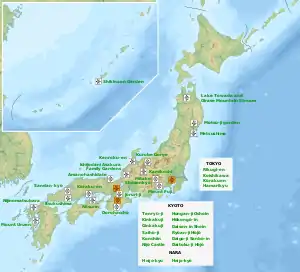
- Parks and gardens
- Bridges and embankments
- Flowering trees, flowering grass, autumn colors, green trees and other places of dense growth
- Places inhabited by birds and wild animals, fish/insects and others
- Rocks, caves
- Ravines, gorges, waterfalls, mountain streams, abysses
- Lakes, marshes, wetlands, floating islands, springs
- Sand dunes, spits, seasides, islands
- Volcanoes, onsen
- Mountains, hills, plateaus, plains, rivers
- Viewpoints
Historic Sites and Special Historic Sites
- Shell mounds, settlement ruins, kofun, other historic ruins of this type
- Ruins of fortified towns, castles, government administration offices, old battlefields and other historic ruins related to politics or government
- Remains of shrines and temples, former compound grounds and other historic ruins related to religion
- Schools, research institutions, cultural facilities and other historic ruins related to education, learning or culture
- Medical care and welfare facilities, life related institution, other society and life related historic ruins
- Transport and communication facilities, forest conservation and flood control facilities, manufacture facilities and other historic sites related to finance or manufacture activities
- Graves and stone monuments with inscriptions
- Former residences, gardens, ponds and other areas of particular historical significance
- Ruins related to foreign countries or foreigners
Natural Monuments and Special Natural Monuments
- Animals
- Well-known animals peculiar to Japan and their habitat
- Animals which are not peculiar to Japan, but need to be preserved as well-known characteristic Japanese animals, and their habitat
- Animals or animal groups peculiar to Japan within their natural environment
- Domestic animals peculiar to Japan
- Well-known imported animals presently in a wild state, with the exception of domestic animals; their habitat
- Particularly valuable animal specimen
- Plants, vegetation
- Old trees of historic interest, gigantic trees, old trees, deformed trees, cultivated pulpwood, roadside trees, shrine forests
- Representative primeval forests, rare forest flora
- Representative alpine plants, special clusters of plants on rock ground
- Representative clusters of waste land plants
- Representative examples of coastal and sand ground vegetation
- Representative examples of areas of peat forming plants
- Clusters of plants growing in caves or grottoes
- Rare water plants in garden ponds, onsen, lakes, marshes, streams, sea, etc.; algae, moss, microbes, etc.
- Remarkable occurrence of epiphytic plants on rocks, trees or shrubs
- Remarkable plant growth on marginal land
- Remarkable growth in the wild of crop plants
- Wild habitat of rare or near extinct plants
- Geological and mineralogical features
- Rocks, mineral and fossil producing sites
- Conformable and unconformable strata
- Fold and thrust strata
- Geological features caused by the work of living creatures
- Phenomena related to earthquake dislocation and landmass motion
- Caves, grottoes
- Examples of rock organization
- Onsen and their sediments
- Erosion and weathering related phenomena
- Fumaroles and other items related to volcanic activity
- Ice and frost related phenomena
- Particularly precious rock, mineral and fossil specimen
- Representative territories rich in natural monuments to be protected (Natural Protected Areas)
Usage
The table's columns (except for Remarks and Photo) are sortable pressing the arrows symbols. The following gives an overview of what is included in the table and how the sorting works.
- Name: name of the monument as registered in the Database of Cultural Properties
- Special Place of Scenic Beauty: criteria under which the monument has been designated or "-" if it is not a Special Place of Scenic Beauty
- Special Historic Site: criteria under which the monument has been designated or "-" if it is not a Special Historic Site
- Special Natural Monument: criteria under which the monument has been designated or "-" if it is not a Special Natural Monument
- Remarks: general remarks
- Location: "town-name prefecture-name" and geo coordinates of the monument if applicable
- sorts as "prefecture-name town-name"
- Photo: picture of the monument
Special Places of Scenic Beauty, Special Historic Sites, Special Natural Monuments
| Name | Special Place of Scenic Beauty | Special Historic Site | Special Natural Monument | Remarks | Location | Photo |
|---|---|---|---|---|---|---|
| Mōtsū-ji garden (毛越寺庭園, mōtsūji teien)[5] | 1 | — |
— |
Hiraizumi, Iwate 38°59′16.31″N 141°6′28.98″E |
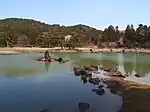 | |
| Matsushima (松島) | 8, 11 | — |
— |
One of the Three Views of Japan | Shiogama, Shichigahama, Rifu, Matsushima, Higashimatsushima, Miyagi 38°21′59.13″N 141°4′27.87″E |
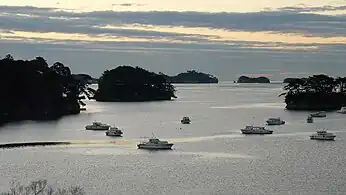 |
| Hamarikyu Gardens (旧浜離宮庭園, kyū hamarikyū teien)[6] | 1 | 2,8 | — |
Tokyo 35°39′35.3″N 139°45′46.5″E |
 | |
| Koishikawa Kōrakuen Garden (小石川後楽園, koishikawa kōrakuen)[7] | 1 | 8 | — |
Tokyo 35°42′19.63″N 139°44′57.37″E |
.JPG.webp) | |
| Rikugi-en (六義園)[8] | 1 | — |
— |
Tokyo 35°43′58.66″N 139°44′47.48″E |
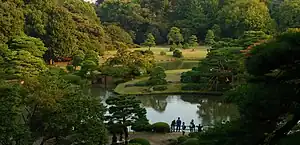 | |
| Kurobe Gorge with Sarutobi Gorge and Mount Okukane (黒部峡谷 附 猿飛ならびに奥鐘山, kurobekyōkoku tsuketari sarutobi narabini okukaneyama) | 6 | — |
4 | Tateyama, Kurobe, Toyama 36°37′23.18″N 137°41′11.4″E |
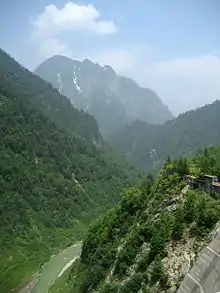 | |
| Kenroku-en (兼六園)[9] | 1 | — |
— |
One of the Three Great Gardens of Japan | Kanazawa, Ishikawa 36°33′43.5″N 136°39′44.99″E |
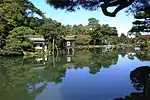 |
| Ichijōdani Asakura Family Gardens (一乗谷朝倉氏庭園, Ichijōdani Asakura-shi teien) | 1 | — |
— |
The ruins at the same site are a Special Historic Site. | Fukui, Fukui 35°59′57.95″N 136°17′43.52″E |
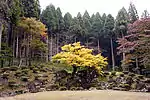 |
| Mitake Shōsenkyō Gorge (御嶽昇仙峡, mitake shōsenkyō)[10] | 5, 6 | — |
— |
Kōfu and Kai, Yamanashi 35°44′41.64″N 138°33′59.29″E |
 | |
| Kamikōchi (上高地)[11] | 6 | — |
4 | Matsumoto, Nagano 36°14′24.93″N 137°37′27.07″E |
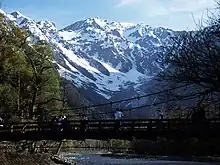 | |
| Konchi-in Garden (金地院庭園, konchiin teien) | 1 | — |
— |
Kyoto, Kyoto 35°0′38.29″N 135°47′24.02″E |
 | |
| Jishō-ji (Ginkaku-ji) Garden (慈照寺(銀閣寺)庭園, jishō-ji (ginkaku-ji) teien)[12] | 1 | 8 | — |
Kyoto, Kyoto 35°1′35.78″N 135°47′54.31″E |
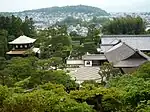 | |
| Rokuon-ji (Kinkaku-ji) Garden (鹿苑寺(金閣寺)庭園, rokuon-ji (kinkaku-ji) teien)[13] | 1 | 8 | — |
Kyoto, Kyoto 35°2′21.38″N 135°43′43.33″E |
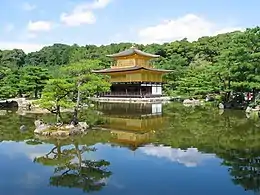 | |
| Jōruri-ji Garden (浄瑠璃寺庭園, jōruri-ji teien) | 1 | — |
— |
Also a historic site (hist-crit.: 8) | Kizugawa, Kyoto 34°42′56.16″N 135°52′22.8″E |
 |
| Saihō-ji Garden (西芳寺庭園, saihō-ji teien)[14] | 1 | — |
— |
Also a historic site (hist-crit.: 8) | Kyoto, Kyoto 34°59′32.5″N 135°41′3.81″E |
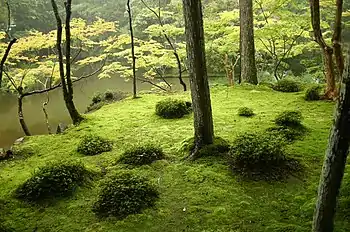 |
| Daisen-in Shoin Garden (大仙院書院庭園, daisenin shoin teien)[15] | 1 | — |
— |
Also a historic site (hist-crit.: 8) | Kyoto, Kyoto 35°2′40.66″N 135°44′45.01″E |
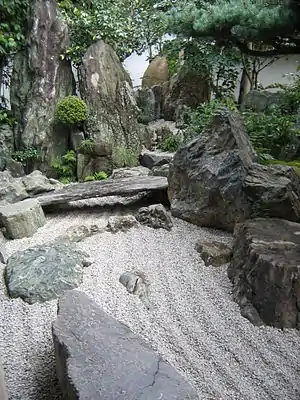 |
| Daitoku-ji Hōjō Garden (大徳寺方丈庭園, daitokuji hōjō teien) | 1 | — |
— |
Also a historic site (hist-crit.: 8) | Kyoto, Kyoto 35°2′40.66″N 135°44′45.01″E |
 |
| Daigo-ji Sanbō-in Garden (醍醐寺三宝院庭園, daigoji sanbōin teien)[16] | 1 | 8 | — |
Kyoto, Kyoto 34°57′6.78″N 135°49′10.2″E |
.jpg.webp) | |
| Amanohashidate (天橋立)[17] | 3, 8, 11 | — |
— |
One of the Three Views of Japan | Miyazu, Kyoto 35°34′12.02″N 135°11′30.59″E |
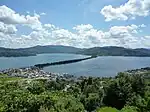 |
| Tenryū-ji Garden (天龍寺庭園, tenryū-ji teien)[18] | 1 | — |
— |
Also a historic site (hist-crit.: 8) | Kyoto, Kyoto 35°0′56.68″N 135°40′23.53″E |
 |
| Nijō Castle Ninomaru Palace Gardens (二条城二之丸庭園, nijōjō ninomaru teien)[19] | 1 | — |
— |
Kyoto, Kyoto 35°0′48.27″N 135°44′57.22″E |
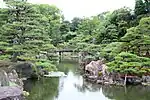 | |
| Hōkongō-in Seijo no taki waterfall and Mount Goisan (法金剛院青女滝 附 五位山, hōkongōin seijo no taki tsuketari goisan) | 1, 10 | — |
— |
Kyoto, Kyoto 35°1′11.77″N 135°42′59.03″E |
 | |
| Hongan-ji Ōshoin Garden (本願寺大書院庭園, honganji ōshoin teien) | 1 | — |
— |
Also a historic site (hist-crit: 8) | Kyoto, Kyoto 34°59′27.37″N 135°45′4.47″E |
|
| Ryōan-ji Hōjō Garden (龍安寺方丈庭園, ryōanji hōjō teien) | 1 | — |
— |
Also a historic site (hist-crit: 8) | Kyoto, Kyoto 35°2′3.81″N 135°43′5.42″E |
 |
| Garden at the Eastern Heijō Palace (平城宮東院庭園, Heijō-kyū tōin teien)[20] | 1 | — |
— |
Reconstruction of an 8th-century Imperial Palace Garden with ponds and pebble shore | Nara, Nara 34°41′28″N 135°47′44″E |
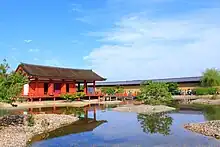 |
| Heijō-kyō Sakyō Sanjō Nibō Palace Garden (平城京左京三条二坊宮跡庭園, heijōkyō sakyō sanjō nibō miyaato teien)[21] | 1 | 2, 8 | — |
The ruins at the same site are a Special Historic Site. | Nara, Nara 34°41′1.45″N 135°48′8.44″E |
|
| Okayama Kōraku-en (岡山後楽園, okayama kōrakuen)[22] | 1 | — |
— |
One of the Three Great Gardens of Japan | Okayama, Okayama 34°40′3.94″N 133°56′7.78″E |
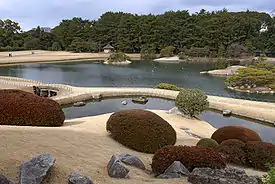 |
| Itsukushima (厳島)[23] | 8 | 2,3 | — |
Includes one of the Three Views of Japan | Hatsukaichi, Hiroshima 34°17′1.99″N 132°19′5.9″E |
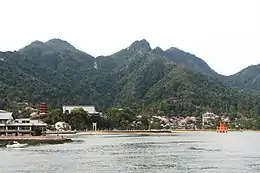 |
| Sandan-kyō ravine (三段峡, sandan-kyō) | 3,5,6 | — |
— |
Akiōta, Hiroshima 34°37′28.85″N 132°11′8.97″E |
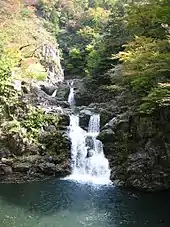 | |
| Ritsurin Garden (栗林公園, ritsurin kōen)[24] | 1 | — |
— |
Takamatsu, Kagawa 34°19′39.2″N 134°2′35.76″E |
 | |
| Nijinomatsubara (虹の松原)[25] | 3,9 | — |
— |
Karatsu, Saga 33°26′35.99″N 130°0′34.37″E |
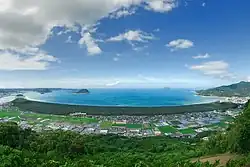 | |
| Mount Unzen (雲仙岳, unzendake) | 1, 3, 9, 10 | — |
— |
Shimabara, Nagasaki 32°45′37.54″N 130°17′31.25″E |
 | |
| Shikinaen Garden (識名園, shikinaen) | 1 | — |
— |
Naha, Okinawa 26°12′14.1″N 127°42′55.32″E |
 | |
| Lake Towada and Oirase Mountain Stream (十和田湖および奥入瀬渓流, towadako oyobi oirasekeiryū) | 6, 7 | — |
— |
Also a Natural Monument (4) | Towadako, Aomori and Kosaka, Akita 40°28′23.05″N 140°52′39.67″E |
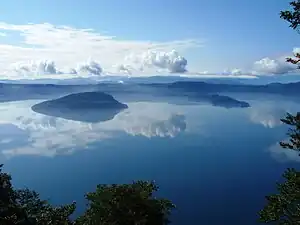
|
| Dorohacchō Gorge (瀞八丁, dorohacchō) | 5,6 | — |
— |
Also a Natural Monument (3.1) | Kumanogawa, Wakayama, Kiwa, Mie and Totsukawa, Nara 33°52′23.24″N 135°51′27.43″E |
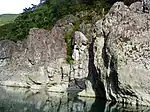 |
| Mount Fuji (富士山, fujisan) | 10 | — |
— |
Yamanashi, Shizuoka 35°21′28.8″N 138°43′51.6″E |
 | |
| Goryōkaku site (五稜郭跡, goryōkakuato)[26] | — |
2 | — |
Star fort of the Republic of Ezo | Hakodate, Hokkaidō 41°47′49.8″N 140°45′24.3″E |
 |
| Sannai-Maruyama Site (三内丸山遺跡, Sannai Maruyama iseki)[27] | — |
1 | — |
Jōmon period archaeological site | Aomori, Aomori 40°48′40.24″N 140°41′44.3″E |
 |
| Chūson-ji compound (中尊寺境内, chūsonji keidai)[28] | — |
3 | — |
Hiraizumi, Iwate 39°0′6.68″N 141°6′0.46″E |
 | |
| Muryōkōin site (無量光院跡, muryōkōinato) | — |
3 | — |
Hiraizumi, Iwate 38°59′36.08″N 141°6′56.81″E |
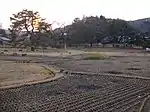 | |
| Site of a Chinjusha attached to the Mōtsū-ji compound (毛越寺境内 附 鎮守社跡, mōtsūji keidai tsuketari chinjushaato)[29] | — |
3 | — |
Hiraizumi, Iwate 38°59′13.89″N 141°6′27.26″E |
||
| Site of a temple attached to the site of the Taga Castle (多賀城跡 附 寺跡, tagajōato tsuketari teraato)[30][31] | — |
2, 3 | — |
Tagajō, Miyagi 38°17′57.54″N 140°59′52.41″E |
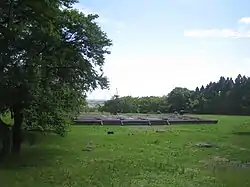 | |
| Ōyu Stone Circle (大湯環状列石, ōyu kanjō resseki)[32] | — |
1 | — |
Kazuno, Akita 40°16′16.96″N 140°48′15.06″E |
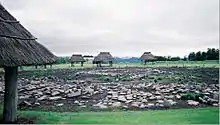 | |
| Former Kōdōkan School (旧弘道館, kyūkōdōkan)[33] | — |
4 | — |
Former school of the Mito Clan, founded in 1841 by Tokugawa Nariaki | Mito, Ibaraki 36°22′31.54″N 140°28′38.27″E |
 |
| Hitachi Kokubun-ji site (常陸国分寺跡, hitachi kokubunjiato)[34] | — |
3 | — |
Ishioka, Ibaraki 36°11′48.17″N 140°16′25.38″E |
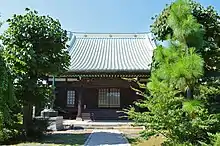 | |
| Hitachi Kokubun Nunnery site (常陸国分尼寺跡, hitachi kokubun nijiato)[35] | — |
3 | — |
Ishioka, Ibaraki 36°12′6.18″N 140°16′3.25″E |
||
| Ōya Magaibutsu (大谷磨崖仏, ōya magaibutsu) | — |
3 | — |
Stone reliefs of Buddhist deities in a cave | Utsunomiya, Tochigi 36°35′46.35″N 139°49′16.94″E |
|
| Cedar Avenue of Nikkō and attached donation monuments (日光杉並木街道 附 並木寄進碑, nikkō suginamiki kaidō tsuketari namiki kishinhi)[36][37] | — |
6 | 2.1 | Three roads totalling 37 km (23 mi) | Nikkō, Imaichi and Kanuma, Tochigi 36°35′46.35″N 139°49′16.94″E |
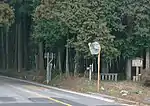
|
| Kanaizawa Stele (金井沢碑, kanaizawahi)[38] | — |
3, 7 | — |
110 cm (43 in) high stone stele from 726 | Takasaki, Gunma 36°17′8.37″N 139°0′58.21″E |
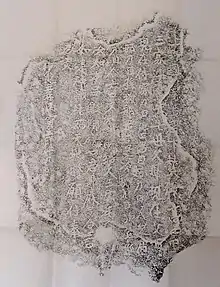 |
| Yamanoue stele and kofun (山上碑及び古墳, yamanouehi oyobi kofun)[39] | — |
1, 7 | — |
Takasaki, Gunma 36°16′37.48″N 139°1′40.09″E |
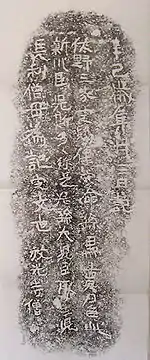 | |
| Tago Stele (多胡碑, tagohi)[40] | — |
2, 7 | — |
Takasaki, Gunma 36°15′54.1″N 138°59′46.67″E |
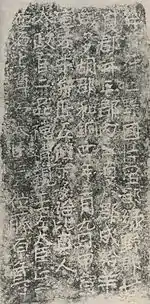 | |
| Edo Castle site (江戸城跡, edojōato) | — |
2 | — |
Tokyo 35°41′8.93″N 139°45′23.95″E |
 | |
| Kasori Shell Mound (加曽利貝塚, Kasori Kaizuka)[41] | — |
1 | — |
Mid to late Jōmon period shell mound. Largest shell heap in Japan. | Wakaba Ward, Chiba, Chiba, Chiba 35°37′24″N 140°9′53″E |
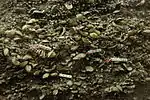 |
| Ichijōdani Asakura Family Historic Ruins (一乗谷朝倉氏遺跡, Ichijōdani Asakura-shi iseki)[42] | — |
2, 3, 6, 7, 8 | — |
The gardens at the same site are a Special Place of Scenic Beauty. | Fukui, Fukui 35°59′57.95″N 136°17′43.52″E |
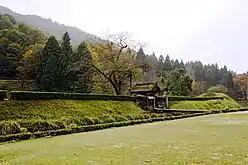 |
| Togari Ishi Stone Age ruins (尖石石器時代遺跡, togariishi sekkijidai iseki) | — |
1 | — |
Jōmon period archaeological site | Chino, Nagano 36°0′46.32″N 138°13′55.04″E |
|
| Tōtomi Kokubun-ji site (遠江国分寺跡, tōtomi kokubunjiato)[43] | — |
3 | — |
Iwata, Shizuoka 34°43′10.45″N 137°51′5.75″E |
||
| Arai Barrier site (新居関跡, arainosekiato)[44][45] | — |
6 | — |
Set up by Tokugawa Ieyasu | Arai, Shizuoka 34°41′40.99″N 137°33′40.82″E |
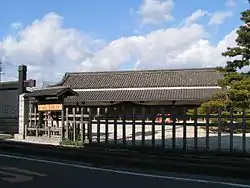 |
| Toro archaeological site (登呂遺跡, toro iseki)[46] | — |
1 | — |
Late Yayoi archaeological site | Shizuoka, Shizuoka 34°57′22.26″N 138°24′29.74″E |
 |
| Nagoya Castle site (名古屋城跡, nagoyajōato) | — |
2 | — |
Nagoya, Aichi 35°11′5.8″N 136°53′58.77″E |
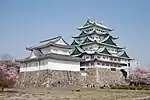 | |
| Former residence of Motoori Norinaga (本居宣長旧宅 同 宅跡, Motoori Norinaga kyūtaku dōtakuato)[47] | — |
8 | — |
Matsusaka, Mie 34°34′30.9″N 136°31′32.94″E |
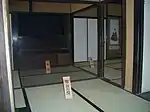 | |
| Azuchi Castle site (安土城跡, azuchijōato) | — |
2 | — |
Azuchi and Higashiōmi, Shiga 35°9′21.25″N 136°8′21.79″E |
 | |
| Hikone Castle site (彦根城跡, hikonejōato) | — |
2 | — |
Hikone, Shiga 35°16′35.87″N 136°15′9.02″E |
 | |
| Osaka Castle site (大坂城跡, osakajōato) | — |
2 | — |
Osaka, Osaka 34°41′14.3″N 135°31′35.04″E |
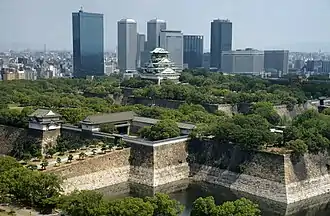 | |
| Kudara-dera site (百済寺, kuderaderaato) | — |
3 | — |
Hirakata, Osaka 34°48′55.29″N 135°39′39.15″E |
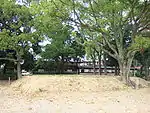 | |
| Himeji Castle site (姫路城跡, himejijōato)[48] | — |
2 | — |
Himeji, Hyōgo 34°50′18.85″N 134°41′34.97″E |
 | |
| Kitora Tomb (キトラ古墳, kitora kofun)[49] | — |
1 | — |
Asuka, Nara 34°27′5.25″N 135°48′18.49″E |
 | |
| Takamatsuzuka Tomb (高松塚古墳, takamatsuzuka kofun)[50] | — |
1 | — |
Asuka, Nara 34°27′43.94″N 135°48′23.2″E |
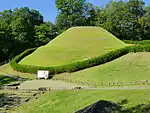 | |
| Yama-dera site (山田寺跡, yamadaderaato)[51] | — |
3 | — |
Sakurai, Nara 34°29′4.02″N 135°49′48.09″E |
 | |
| Ishibutai Kofun (石舞台古墳)[52] | — |
1 | — |
Asuka, Nara 34°28′0.15″N 135°49′33.88″E |
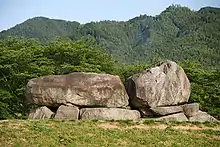 | |
| Suyama Kofun (巣山古墳)[53] | — |
1 | — |
Kōryō, Nara 34°33′23.06″N 135°44′27.63″E |
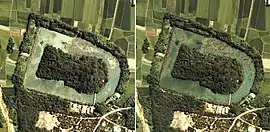 | |
| Fujiwara Palace site (藤原宮跡, fujiwara kyūseki)[54] | — |
2 | — |
Palace of the Fujiwara capital | Kashihara, Nara 34°30′8.71″N 135°48′26.44″E |
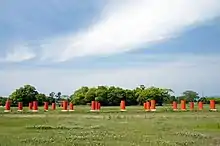 |
| Monjuin Nishi Kofun (文殊院西古墳)[55] | — |
1 | — |
Sakurai, Nara 34°30′13.55″N 135°50′33.21″E |
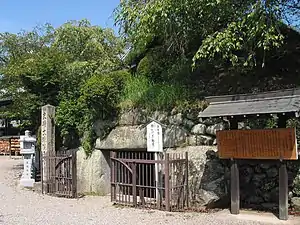 | |
| Heijō Palace site (平城宮跡, heijō kyūseki)[56] | — |
2 | — |
Palace of the Heijō capital; the gardens at the same site are a Special Place of Scenic Beauty | Nara, Nara 34°41′28.46″N 135°47′42.02″E |
.JPG.webp) |
| Moto Yakushi-ji site (本薬師寺跡, motoyakushijiato)[57] | — |
3 | — |
Yakushi-ji of the Fujiwara capital | Kashihara, Nara 34°29′33.88″N 135°48′0.95″E |
|
| Iwase Senzuka Kofun Group (岩橋千塚古墳群, iwase senzuka kofungun)[58] | — |
1 | — |
Wakayama, Wakayama 34°13′33.08″N 135°13′38.9″E |
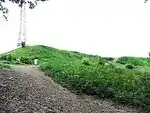 | |
| Sai no Ohai-ji site (斎尾廃寺跡, sainoohaijiato) | — |
3 | — |
Tōhaku, Tottori 35°28′53.65″N 133°42′41.13″E |
||
| Former Shizutani School with Camelia mound, stone gate, site of the residence of Tsuda Nagatada and tea house (旧閑谷学校 附 椿山石門津田永忠宅跡および黄葉亭, kyūshizutanigakkō tsuketari tsubakiyama sekimon tsudanagatadatakuato oyobi kōyōtei)[59][60] | — |
4 | — |
Bizen, Okayama 34°47′46.77″N 134°13′10.23″E |

| |
| Renjuku Fourmer Chazan Kan house (廉塾ならびに菅茶山旧宅, renjuku narabini kansazankyūtaku)[61][62] | — |
4, 8 | — |
Chazan Kan (1748–1827) was a Confucian scholar. | Fukuyama, Hiroshima 34°32′41.26″N 133°23′4.1″E |
|
| Sanuki Kokubun-ji site (讃岐国分寺跡, sanuki kokubunjiato)[63] | — |
3 | — |
Temple 80 of the Shikoku pilgrimage | Takamatsu, Kagawa 34°18′13.18″N 133°56′39.65″E |
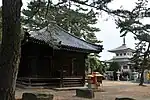 |
| Ōzuka Kofun (王塚古墳)[64] | — |
1 | — |
Keisen, Fukuoka 33°35′19.47″N 130°39′49.84″E |
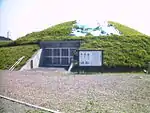 | |
| Mizuki site (水城跡, mizukiato) | — |
2 | — |
Low embankment built in 664 by the Dazaifu (大宰府), the imperial office governing Kyūshū, against an invasion from Tang dynasty China and Korea | Dazaifu, Kasuga and Ōnojō, Fukuoka 33°31′2.41″N 130°29′28.42″E |
 |
| Dazaifu site (大宰府跡, dazaifuato)[65] | — |
2 | — |
Ruins of the governmental office with jurisdiction over Kyūshū | Dazaifu, Fukuoka 33°30′52.43″N 130°30′54.55″E |
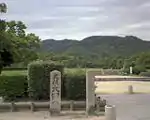 |
| Ōnojō Castle Ruins (大野城跡, ōnojōato)[66] | — |
2, 3 | — |
Asuka period castle | Dazaifu, Umi and Ōnojō, Fukuoka 33°31′16.9″N 130°30′54.01″E |
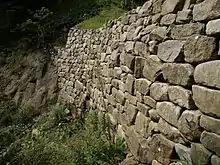 |
| Yoshinogari site (吉野ヶ里遺跡, yoshinogari iseki)[67] | — |
1 | — |
Yayoi period archaeological site | Yoshinogari, Saga 33°19′25.18″N 130°23′6.43″E |
 |
| Nagoya Castle ruined foundations (名護屋城跡並陣跡, nagoyajōato narabini jinato)[68] | — |
2 | — |
Chinzei, Yobuko and Genkai, Saga 33°31′48.65″N 129°52′9.75″E |
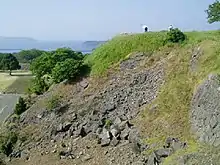 | |
| Kaneda Castle site (金田城跡, kanedajōato)[69] | — |
2 | — |
Asuka period mountain castle | Tsushima, Nagasaki 34°16′6.07″N 129°18′49.69″E |
|
| Haru no Tsuji Site (原の辻遺跡, haru no tsujii seki)[70] | — |
1 | — |
Iki, Nagasaki 33°45′48.68″N 129°44′55.04″E |
||
| Kumamoto Castle site (熊本城跡, kumamotojōato) | — |
2 | — |
Kumamoto, Kumamoto 32°48′20.55″N 130°42′21.21″E |
 | |
| Usuki Stone Buddhas with five-storied stone pagoda and two gorintō with inscriptions from 1170 and 1172 (臼杵磨崖仏 附 日吉塔、嘉応二年在銘五輪塔 承安二年在銘五輪塔, usuki magaibutsu tsuketari hiyoshitō kaōninenzaimei gorintō jōanninenzaimei gorintō)[71][72] | — |
3 | — |
Usuki, Ōita 33°5′26.18″N 131°45′47.04″E |
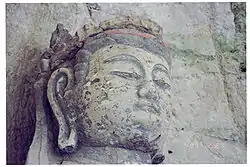 | |
| Saitobaru Burial Mounds (西都原古墳群, saitobaru kofun-guni)[73] | — |
1 | — |
Saito, Miyazaki 32°7′14.95″N 131°23′17.84″E |
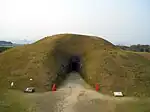 | |
| Kii Castle site (基肄(椽)城跡, kiijōato)[74] | — |
2 | — |
Chikushino, Fukuoka and Kiyama, Saga 33°26′39.34″N 130°30′36.09″E |
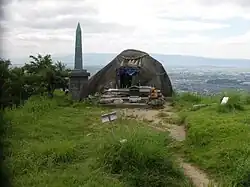 | |
| Mount Apoi alpine plant community (アポイ岳高山植物群落, apoidake kōzanshokubutsu gunraku) | — |
— |
2.3 | Samani, Hokkaidō 42°6′25.35″N 143°1′41.89″E |
||
| Marimo of Lake Akan (阿寒湖のマリモ, akanko no marimo) | — |
— |
2.12, 2.8 | Akan, Hokkaidō 43°27′1.54″N 144°5′57.93″E |
 | |
| Showashinzan (昭和新山) | — |
— |
3.10 | Sōbetsu, Hokkaidō 42°32′37.17″N 140°51′51.77″E |
 | |
| Daisetsuzan (大雪山) | — |
— |
4 | Kamikawa, Higashikawa, Biei and Shintoku, Hokkaidō 43°40′58.87″N 142°53′55.78″E |
 | |
| Nopporo Forest Park (野幌原始林, nopporo genshirin) | — |
— |
2.2 | Kitahiroshima, Hokkaidō 43°3′12.46″N 141°30′3.09″E |
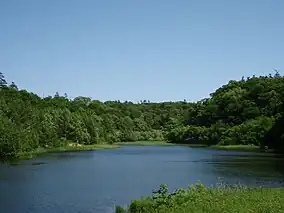 | |
| Swans on Kominato beach and their wintering place (小湊のハクチョウおよびその渡来地, kominato no hakuchō oyobi sono toraichi) | — |
— |
1.2 | Whooper swans | Asadokoro, Hiranai, Aomori 40°56′14.09″N 140°58′23.88″E |
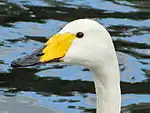 |
| Getō Onsen Tufa (夏油温泉の石灰華, getō onsen no sekkaika) | — |
— |
3.8 | Kitakami, Iwate 39°12′36.64″N 140°52′55.74″E |
 | |
| Nesori petrified wood (根反の大珪化木, nesori no daikeikaboku) | — |
— |
3.1 | 15–20 million years old | Ichinohe, Iwate 40°11′24.78″N 141°20′4.42″E |
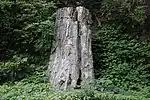 |
| Yakehashiri lava flow (焼走り熔岩流, yakehashiri yōganryū) | — |
— |
3.5, 3.10 | Nishine, Iwate 39°52′30.82″N 141°2′51.16″E |
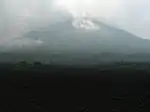 | |
| Mount Hayachine and Yakushidake alpine zone, forest vegetation (早池峰山および薬師岳の高山帯・森林植物群落, hayachinesan oyobi yakushidake no kōzantai shinrin shokubutsugunraku) | — |
— |
2.3 | Hanamaki, Tōno and Kawai, Iwate 39°31′53.71″N 141°28′26.53″E |
||
| onikōbe no megama oyobi ogama kanketsu onsen (鬼首の雌釜および雄釜間歇温泉) | — |
— |
3.8 | Ōsaki, Miyagi 38°48′0.19″N 140°38′52.81″E |
||
| Tamagawa Hot Spring hokutolite (玉川温泉の北投石, tamagawa onsen no hokutōseki) | — |
— |
3.1, 3.8 | Hokutolite is a type of radioactive baryte. | Semboku, Akita 39°57′42.57″N 140°43′42.18″E |
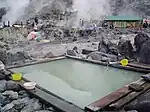 |
| Mount Haguro cedar avenue (羽黒山のスギ並木, hagursan no suginamiki) | — |
— |
2.1 | Tsuruoka, Yamagata 38°42′13.91″N 139°58′13.33″E |
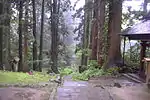 | |
| Large zelkova tree of Higashine (東根の大ケヤキ, higashine no ōkeyaki) | — |
— |
2.1 | More than 1000 years old, and perimeter larger than 12 (m), largest zelkova tree in Japan | Higashine, Yamagata 38°26′31.16″N 140°24′6.28″E |
|
| Natural habitat Pinguicula ramosa (コウシンソウ自生地, higashine no ōkeyaki) | — |
— |
2.12 | A species of butterwort endemic to Nikkō National Park | Nikkō, Tochigi 36°40′27.13″N 139°21′42.9″E |
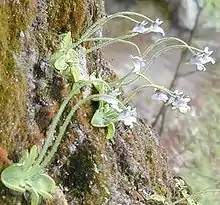 |
| Mount Asama lava tree mold (浅間山熔岩樹型, asamayama yōganjukei) | — |
— |
3.2, 3.7, 3.10 | Tsumagoi, Gunma 36°26′53.57″N 138°30′56.25″E |
||
| Sakitama Kofun Group (埼玉古墳群, sakitama kofungun)[75] | — |
1 | — |
A large group of kofun comprising Maruhakayama Kofun, Futagoyama Kofun, Teppōyama Kofun, Shōgunyama Kofun, Nakanoyama Kofun, Kawarazuka Kofun, Okunoyama Kofun, Atagoyama Kofun and Inariyama Kofun whose artifacts have been designated as National Treasure of Japan. | Gyōda, Saitama 36°7′37″N 139°28′44″E |
|
| Wisteria at Ushijima (牛島のフジ, ushijima no fuji) | — |
— |
2.1 | Kasukabe, Saitama 35°59′5.83″N 139°46′24.07″E |
||
| Kagami-iwa rock at Mount Mitake (御獄の鏡岩, mitake no kagamiiwa) | — |
— |
3.1, 3.5 | Kamikawa, Saitama 36°10′45.91″N 139°4′14.18″E |
||
| Tajimagahara Primula sieboldii primrose habitat (田島ヶ原サクラソウ自生地, tajimagahara sakurasō jiseichi) | — |
— |
2.4 | Saitama, Saitama 35°50′17.41″N 139°36′56.66″E |
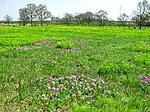 | |
| Tai-no-ura sea bream habitat (鯛の浦タイ生息地, tai no ura tai seisokuchi)[76] | — |
— |
1.3 | Kamogawa, Chiba 35°7′5.98″N 140°11′28.67″E |
 | |
| Ōshima cherry tree (大島のサクラ株, ōshima no sakurakabu) | — |
— |
2.1 | Single tree, 7.9 m (26 ft) circumference; species is native to Ōshima and Izu Peninsula | Ōshima, Tokyo 34°45′49.01″N 139°26′3.07″E |
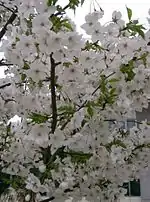 |
| Firefly squid sea surface group (ホタルイカ群遊海面, hotaruika-gun yūkaimen) | — |
— |
1.3 | Toyama and Uozu, Toyama 36°46′36.01″N 137°20′40.69″E |
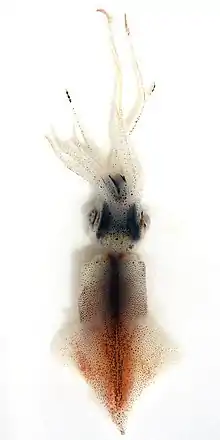 | |
| Uozu buried forest (魚津埋没林, uozu maibutsurin) | — |
— |
3.1, 3.5 | Tree trunks of a cedar forest partially buried about 2000 years ago; largest has a circumference of c. 12 m (39 ft) | Shakadō, Uozu, Toyama 36°49′31.5″N 137°24′23.53″E |
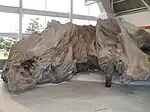 |
| Yakushidake cirque group (薬師岳の圏谷群, yakushidake no kenkokugun) | — |
— |
3.11 | Toyama, Toyama 36°28′5.64″N 137°32′38.48″E |
 | |
| Sinter cones (岩間の噴泉塔群, iwama no funsentōgun) | — |
— |
3.8 | Hakusan, Ishikawa 36°13′39.32″N 136°46′11.69″E |
||
| Narusawa lava tree mold (鳴沢熔岩樹型, narusawayōganjukei) | — |
— |
3.6, 3.10 | Narusawa, Yamanashi 35°25′34.06″N 138°42′3.05″E |
 | |
| Shirahone Onsen stalagmite and spherical limestones (白骨温泉の噴湯丘と球状石灰石, shirahone onsen no funtōkyū to kyūjōsekkaiseki) | — |
— |
3.8 | Matsumoto, Nagano 36°8′51.72″N 137°37′28.85″E |
||
| Neodani Fault (根尾谷断層, neodani dansō) | — |
— |
3.5 | Motosu, Gifu 35°37′1.62″N 136°37′14.98″E |
 | |
| Itoshiro cedar (石徹白のスギ, itoshiro no sugi) | — |
— |
2.1 | Circumference 14 m (46 ft) | Gujō, Gifu 36°0′5.83″N 136°46′18.49″E |
 |
| Kariyado gebazakura (狩宿の下馬ザクラ, kariyado no gebazakura) | — |
— |
2.1 | Oldest tree of the mountain sakura, crown 21.81 m (71.6 ft) (EW) and 16.33 m (53.6 ft) (NS) | Fujinomiya, Shizuoka 35°18′6.92″N 138°35′19.59″E |
|
| Wakutama pond (湧玉池, wakutama no ike) | — |
— |
3.10 | Fujinomiya, Shizuoka 35°13′38.07″N 138°36′41.14″E |
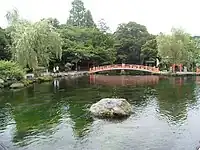 | |
| Nagaoka fireflies and their habitat (長岡のゲンジボタルおよびその発生地, nagaoka no genjibotaru oyobi sono hassei) | — |
— |
1.2 | Maibara, Shiga 35°21′22.54″N 136°22′4.84″E |
||
| Kasugayama Primeval Forest (春日山原始林, kasugayama genshirin) | — |
— |
2.2 | Part of the World Heritage Site "Historic Monuments of Ancient Nara" | Nara, Nara 34°40′56.19″N 135°51′46.13″E |
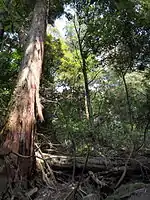 |
| Daisen agarwood single species forest (大山のダイセンキャラボク純林, daisen no daisenkyaraboku junrin) | — |
— |
2.2 | Daisen, Tottori 35°29′0.95″N 133°30′28.51″E |
||
| Daikon Island lava tubes (大根島の熔岩隧道, daikonjima no yōganzuidō) | — |
— |
3.6, 3.10 | Matsue, Shimane 35°29′42.59″N 133°10′34.42″E |
 | |
| Akiyoshi plateau (秋吉台, akiyoshidai) | — |
— |
3.1, 3.3, 3.6, 3.9 | Karst topography | Mine, Yamaguchi 34°14′11.14″N 131°17′26.05″E |
|
| Akiyoshi cave (秋芳洞, akiyoshidō) | — |
— |
3.6, 3.9 | At 8.7 km (5.4 mi) second longest cave in Japan | Mine, Yamaguchi 34°13′40.17″N 131°18′12.32″E |
 |
| Cranes at Yashiro and their wintering place (八代のツルおよびその渡来地, yashiro no tsuru oyobi sono toraichi) | — |
— |
1.2 | Hooded cranes | Shūnan and Kudamatsu, Yamaguchi 34°5′56.19″N 131°56′49.83″E |
|
| Giant camphor tree in Kamo (加茂の大クス, kamo no ōkusu) | — |
— |
2.1 | Higashimiyoshi, Tokushima 34°2′27.39″N 133°55′54.92″E |
||
| Chinese juniper at Hōshō-in (宝生院のシンパク, hōshōin no shinpaku) | — |
— |
2.1 | 23 m (75 ft) high, 15 m (49 ft) circumference at ground level | Tonoshō, Kagawa 34°29′36.11″N 134°11′49.86″E |
|
| Yakama potholes (八釜の甌穴群, yakama no ōketsugun) | — |
— |
3.9 | Kumakōgen, Ehime 33°42′13.6″N 132°57′38.39″E |
||
| Common jay at Kōchi and its habitat (高知市のミカドアゲハおよびその生息地, kōchishi no mikadoageha oyobi sono seisokuchi) | — |
— |
1.2 | Kōchi, Kōchi 33°33′13.06″N 133°32′24.07″E |
 | |
| Giant cedars at Sugi (杉の大スギ, sugi no ōsugi) | — |
— |
2.1 | Two stems, each about 16 m (52 ft) circumference | Ōtoyo, Kōchi 33°45′20.17″N 133°39′47.01″E |
|
| Japanese Box primeval forest at Mount Kosho (古処山ツゲ原始林, koshosan tsuge genshirin) | — |
— |
2.1 | Asakura and Kama, Fukuoka 33°28′54.67″N 130°43′29.8″E |
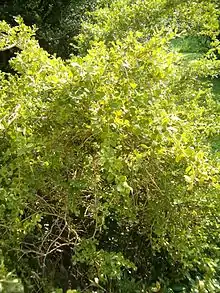 | |
| Camphor tree primeval forest at Mount Tachibana (立花山クスノキ原始林, tachibanayama kusunoki genshirin) | — |
— |
2.2, 2.10 | Shingū and Hisayama, Fukuoka 33°40′45.67″N 130°28′6.23″E |
 | |
| Mucuna sempervirens at Aira (相良のアイラトビカズラ, aira no airatobikazura) | — |
— |
2.1, 2.12 | Kikuka, Kumamoto 33°3′51.16″N 130°46′5.53″E |
||
| Aoshima subtropical plant communities (青島亜熱帯性植物群落, aoshima anettai seishokubutsugunraku) | — |
— |
2.2 | Aoshima, Miyazaki, Miyazaki 31°48′18.69″N 131°28′32.7″E |
 | |
| Sago palm natural habitat at Cape Toi (都井岬ソテツ自生地, toimisaki sotetsu jiseichi) | — |
— |
2.10 | Kushima, Miyazaki 31°21′54.78″N 131°20′24.03″E |
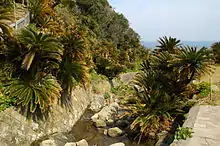 | |
| Mitrastema at Uchiumi (内海のヤッコソウ発生地, uchiumi no yakkosō hasseichi) | — |
— |
2.12 | Mitrastema yamamotoi | Miyazaki, Miyazaki 31°44′28.97″N 131°28′3.81″E |
|
| Yakushima primeval cedar forest (屋久島スギ原始林, yakushima sugi genshirin) | — |
— |
2.2 | Includes with the Jōmon Sugi, the oldest specimen of Cryptomeria japonica | Yakushima, Kagoshima 30°19′40.23″N 130°31′23.06″E |
 |
| Kamō camphor tree (蒲生のクス, kamō no kesu) | — |
— |
2.1 | Height: 30 m (98 ft), circumference: 24 m (79 ft) | Kamō, Kagoshima 31°45′44.38″N 130°34′11.77″E |
 |
| Origin of Kandelia obovata at Kiire (喜入のリュウキュウコウガイ産地, kiire no ryūkyōkōgai sanchi) | — |
— |
2.10 | Kagoshima, Kagoshima 31°22′29.34″N 130°32′49.26″E |
 | |
| Natural habitat of the sago palm in Kagoshima Prefecture (鹿児島県のソテツ自生地, kagoshimaken no sotetsu jiseichi) | — |
— |
2.10 | Yamagawa, Bonotsu, Sata and Uchinoura, Kagoshima 31°21′13.09″N 130°42′15.64″E |
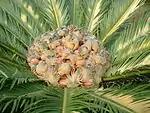 | |
| Cranes in Kagoshima Prefecture and their wintering place (鹿児島県のツルおよびその渡来地, kagoshimaken no tsuru oyobi sono toraichi) | — |
— |
1.2 | Hooded cranes | Izumi, Kagoshima 32°6′9.52″N 130°16′25.75″E |
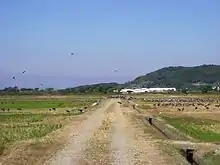 |
| Birōjima subtropical plant communities (枇榔島亜熱帯性植物群落, birōjima anettai seishokubutsugunraku) | — |
— |
2.2, 2.10 | Shibushi, Kagoshima 31°25′45.3″N 131°7′1.89″E |
 | |
| Shirouma mountain range alpine plant zone (白馬連山高山植物帯, shiroumarenzan kōzanshokubutsutai) | — |
— |
2.3 | Asahi and Kurobe in Toyama; Hakuba in Nagano; Itoigawa in Niigata 36°38′56.9″N 137°44′55.73″E |
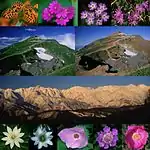 | |
| Ozegahara (尾瀬, oze) | — |
— |
4 | Yunotani, Niigata; Katashina, Gunma; Hinoemata, Fukushima 36°56′33.93″N 139°13′59.41″E |
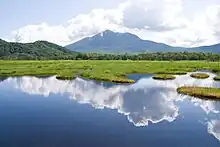 | |
| Short-tailed albatross (アホウドリ, ahōdori) | — |
— |
1.2 | Ogasawara Islands (Tokyo) and Okinawa | 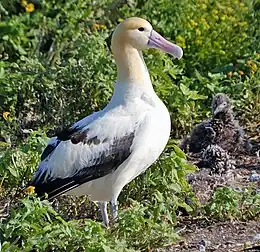 | |
| Amami rabbit (アマミノクロウサギ, amami no kuro usagi) | — |
— |
1.1 | Tokunoshima and Amami Ōshima, Kagoshima |  | |
| Iriomote cat (イリオモテヤマネコ, iriomote yamaneko) | — |
— |
1.1 | Endemic to one island (Iriomote) | Iriomote, Okinawa | 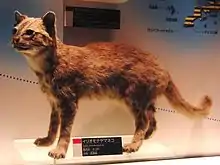 |
| Japanese giant salamander (オオサンショウウオ, ōsanshōuo) | — |
— |
1.2 | At up to 1.5 m (4 ft 11 in) length, the second largest salamander in the world[77] | 11 prefectures, among others: Gifu, Mie, Hyōgo, Hiroshima, Shimane, Tottori, Ōita |  |
| Japanese serow (カモシカ, kamoshika) | — |
— |
1.1 | found on all main Japanese islands except for Hokkaidō | 29 prefectures including Aomori | 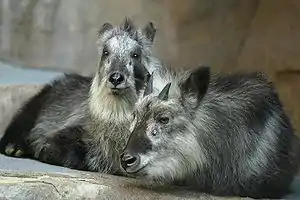 |
| Otter (カワウソ, kawauso) | — |
— |
1.2 | various | 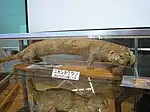 | |
| Crested serpent-eagle (カンムリワシ, kanmuriwashi) | — |
— |
1.1 | Okinawa | 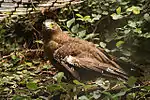 | |
| Oriental stork (コウノトリ, kō no tori) | — |
— |
1.2 | Hyōgo and Fukui |  | |
| Red-crowned crane (タンチョウ, tanchō) | — |
— |
1.2 | Hokkaidō | 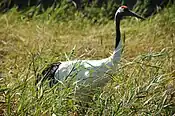 | |
| Crested ibis (トキ, toki) | — |
— |
1.2 | Niigata and Ishikawa |  | |
| Okinawa woodpecker (ノグチゲラ, noguchigera) | — |
— |
1.1 | Endemic to Okinawa Island | Okinawa Island, Okinawa | 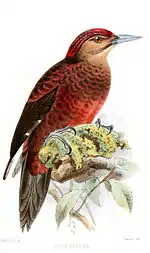 |
| Bonin white-eye (メグロ, meguro) | — |
— |
1.1 | Endemic to the Bonin Islands | Bonin Islands, Tokyo | |
| Rock ptarmigan (ライチョウ, raichō) | — |
— |
1.2 | Toyama, Nagano, Niigata, Yamanashi, Shizuoka, Gifu | 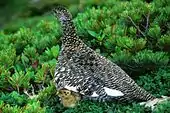 | |
| Long-tailed fowl of Tosa (土佐のオナガドリ, tosa no onagadori) | — |
— |
1.4 | Nankoku, Kōchi |
References
- "Cultural Properties for Future Generations" (PDF). Administration of Cultural Affairs in Japan ― Fiscal 2009. Agency for Cultural Affairs. June 2007. Archived from the original (PDF) on 2009-03-27.
- "Preservation and Utilization of Cultural Properties" (PDF). Administration of Cultural Affairs in Japan ― Fiscal 2009. Agency for Cultural Affairs. 2009. Archived from the original (PDF) on 2007-11-10.
- 史跡等の指定等について [Designation of Historic Sites] (PDF). Agency for Cultural Affairs. 2023-10-24. Retrieved 2022-12-17.
- 昭和二十六年文化財保護委員会告示第二号(国宝及び重要文化財指定基準並びに特別史跡名勝天然記念物及び史跡名勝天然記念物指定基準) [Bulletin of the Association for the rehabilitation of cultural properties, number 2 from 1951 (Designation criteria for National Treasures, Important Cultural Properties, Special Historic Sites, Places of Scenic Beauty, Natural Monuments)] (in Japanese). Tokyo: MEXT. Archived from the original on 2018-01-11. Retrieved 2010-01-01.
- "Motsuji Temple - Special Historic Site and Special Place of Scenic Beauty". Mōtsū-ji. Archived from the original on 2010-09-14. Retrieved 2009-12-18.
- "Hama-rikyu Gardens". Tokyo Metropolitan Park Association. Archived from the original on 2016-10-29. Retrieved 2009-12-18.
- "Koishikawa Korakuen Gardens". Tokyo Metropolitan Park Association. Archived from the original on 2006-04-07. Retrieved 2009-12-18.
- "Rikugien Gardens". Tokyo Metropolitan Park Association. Archived from the original on 2014-02-04. Retrieved 2009-12-18.
- "Kenroku-en". Ishikawa Prefecture. 2003. Retrieved 2009-12-18.
- "Shōsenkyō" (in Japanese). Shosenkyo Kankoukyokai. Archived from the original on 2009-12-16. Retrieved 2009-12-18.
- "Kamikōchi". Kamikōchi. Archived from the original on 2009-10-05. Retrieved 2009-12-18.
- "Ginkaku-ji". Shōkoku-ji. Archived from the original on 2010-07-28. Retrieved 2009-12-18.
- "Kinkaku-ji". Shōkoku-ji. Archived from the original on 2010-04-30. Retrieved 2009-12-18.
- "Koke - dera". Kyoto Prefectural Government Tourism Division. Archived from the original on 2010-03-08. Retrieved 2009-12-18.
- "Daisen-in" (in Japanese). Daisen-in. Retrieved 2009-12-18.
- "Sanbō-in". Daigo-ji. Retrieved 2009-12-18.
- "Amanohashidate". Amanohashidate Tour Association Monju branch. Retrieved 2009-12-18.
- "Tenryū-ji". Kyoto Prefectural Government Tourism Division. Archived from the original on 2009-09-23. Retrieved 2009-12-18.
- "Gardens". Nijō Castle. Archived from the original on 2013-05-10. Retrieved 2009-12-18.
- "Garden at the Eastern Palace, Nara palace site". Japanese Garden Dictionary. Department of Cultural Heritage of the Nara National Research Institute for Cultural Properties. Archived from the original on 2011-07-19. Retrieved 2011-01-29.
- 平城京左京三条二坊宮跡庭園 (in Japanese). Nara Tourism. Archived from the original on 2010-01-30. Retrieved 2009-12-18.
- "Kōraku-en" (in Japanese). Okayama Kōraku-en. Retrieved 2009-12-18.
- "Miyajima". Miyajima Tourist Information. Retrieved 2009-12-18.
- "Ritsurin Garden". Kagawa Prefecture. Retrieved 2009-12-18.
- "Nijinomatsubara". Yokatoko. Archived from the original on 2009-06-09. Retrieved 2009-12-18.
- "Goryōkaku" (in Japanese). Agency for Cultural Affairs. Archived from the original on 2010-03-27. Retrieved 2009-12-18.
- "Sannai-Maruyama Site". Sannai-Maruyama Site. Retrieved 2009-12-18.
- 中尊寺境内 (in Japanese). Cultural Heritage Online. Archived from the original on 2011-10-07. Retrieved 2009-12-18.
- 毛越寺境内附鎮守社跡 (in Japanese). Iwate Prefecture. Retrieved 2009-12-18.
- 特別史跡多賀城跡附寺跡 (in Japanese). Tagajō city. Archived from the original on 2009-04-13. Retrieved 2009-12-18.
- 多賀城跡 附 寺跡 (in Japanese). Cultural Heritage Online. Archived from the original on 2011-10-07. Retrieved 2009-12-18.
- 大湯環状列石 (in Japanese). Ōyu Stone Circle. Archived from the original on 2002-11-06. Retrieved 2009-12-18.
- 弘道館公園 (in Japanese). Ibaraki Prefecture. Archived from the original on 2016-02-14. Retrieved 2009-12-18.
- 常陸国分寺跡 (in Japanese). Ishioka city. Archived from the original on 2011-07-19. Retrieved 2009-12-18.
- 常陸国分尼寺跡 (in Japanese). Ishioka city. Archived from the original on 2011-07-19. Retrieved 2009-12-18.
- "Cedar Avenue of Nikko". Nikko Tourist Association. Archived from the original on 2010-01-04. Retrieved 2009-12-18.
- "Cedar Avenue of Nikko". Nikkō. Archived from the original on 2009-12-11. Retrieved 2009-12-18.
- 金井沢碑 (in Japanese). Takasaki city. Archived from the original on 2011-07-20. Retrieved 2009-12-18.
- 山上碑(やまのうえひ)及び古墳 (in Japanese). Takasaki city. Archived from the original on 2011-07-20. Retrieved 2009-12-18.
- 多胡碑 (in Japanese). Takasaki city. Retrieved 2009-12-18.
- 特別史跡の新指定 [Designation of new Special Historic Sites] (PDF). Agency for Cultural Affairs. 2017-09-14. Retrieved 2017-11-18.
- 一乗谷朝倉氏遺跡 (in Japanese). Fukui city. Archived from the original on 2014-01-03. Retrieved 2009-12-18.
- 遠江国分寺跡 (in Japanese). Iwata city. Archived from the original on December 2, 2009. Retrieved 2009-12-18.
- 新居関跡 (in Japanese). Arai city. Archived from the original on 2009-12-08. Retrieved 2009-12-18.
- 新居関跡 (in Japanese). SHINEI SYSTEMS. Archived from the original on 2011-08-17. Retrieved 2009-12-18.
- 登呂遺跡 (in Japanese). Shizuoka city. Archived from the original on 2009-12-05. Retrieved 2009-12-18.
- "Museum of Motoori Norinaga" (in Japanese). Museum of Motoori Norinaga. Retrieved 2009-12-18.
- 姫路城跡 (in Japanese). Agency for Cultural Affairs. Archived from the original on 2009-02-01. Retrieved 2009-12-18.
- キトラ古墳 (in Japanese). Kashihara Archaeological Institute. Archived from the original on 2009-08-22. Retrieved 2009-12-18.
- "Takamatsuzuka Tomb" (in Japanese). Nara Prefecture. Archived from the original on 2011-03-05. Retrieved 2009-12-18.
- 山田寺跡 (in Japanese). Asuka historical Museum fanclub. Retrieved 2009-12-18.
- 石舞台古墳 (in Japanese). Nara Prefecture. Archived from the original on 2009-06-12. Retrieved 2009-12-18.
- 巣山古墳 (in Japanese). Kōryō town. Retrieved 2009-12-18.
- 藤原宮跡 (in Japanese). Kashihara city. Retrieved 2009-12-18.
- 文殊院西古墳 (in Japanese). Asuka historical Museum fanclub. Retrieved 2009-12-18.
- 平城宮跡 (in Japanese). Nara National Research Institute for Cultural Properties. Archived from the original on 2004-08-14. Retrieved 2009-12-18.
- 本薬師寺跡 (in Japanese). Kashihara. Retrieved 2009-12-18.
- 岩橋千塚古墳群 (in Japanese). Cultural Heritage Online. Archived from the original on 2011-07-23. Retrieved 2009-12-18.
- 旧閑谷学校 (in Japanese). Agency for Cultural Affairs. Retrieved 2009-12-18.
- "Shizutani School". Bizen city. Retrieved 2009-12-18.
- "廉塾ならびに菅茶山旧宅". Hiroshima. Archived from the original on 2010-06-18. Retrieved 2009-12-18.
- "Renjuku/Old Chazan Kan house". Fukuyama Tourist Information. Retrieved 2009-12-18.
- 讃岐国分寺跡 (in Japanese). Cultural Heritage Online. Archived from the original on 2011-07-23. Retrieved 2009-12-18.
- 王塚古墳 (in Japanese). Keisen. Retrieved 2009-12-18.
- 大宰府跡 (in Japanese). Agency for Cultural Affairs. Archived from the original on 2008-05-03. Retrieved 2009-12-18.
- 大野城跡 (in Japanese). Fukuoka Prefecture. Archived from the original on 2010-05-05. Retrieved 2009-12-18.
- "Yoshinogari Historical Park". Yoshinogari Historical Park. Retrieved 2009-12-18.
- 佐賀県:国指定(史跡の部) (in Japanese). Saga Prefecture. Archived from the original on 2011-07-17. Retrieved 2009-12-18.
- 金田城跡 (PDF) (in Japanese). Nagasaki Prefecture. Archived from the original (PDF) on 2011-07-16. Retrieved 2009-12-18.
- 原の辻遺跡 (in Japanese). Nagasaki Prefecture. Archived from the original on December 10, 2008. Retrieved 2009-12-18.
- 臼杵磨崖仏 附 日吉塔、嘉応二年在銘五輪塔 承安二年在銘五輪塔 (in Japanese). Agency for Cultural Affairs. Archived from the original on 2011-07-23. Retrieved 2009-12-18.
- 国宝 臼杵石仏 公式ホームページ (in Japanese). Usuki city. Archived from the original on 2009-12-08. Retrieved 2009-12-18.
- "Saitobaru Burial Mounds" (in Japanese). Saitobaru Burial Mounds. Archived from the original on 2011-05-24. Retrieved 2009-12-18.
- 基肄城跡 (in Japanese). Chikushino city. Retrieved 2009-12-18.
- 史跡等の指定等について [Designation of Historic Sites] (PDF). Agency for Cultural Affairs. 2020-11-22. Retrieved 2020-11-20.
- 鯛の浦タイ生息地 (in Japanese). Kamogawa. Archived from the original on 2008-06-28. Retrieved 2009-12-18.
- Andrias japonicus - Amphibiaweb
